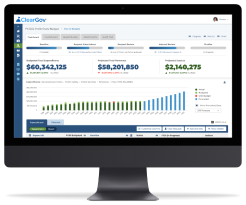6 Reasons School Districts Are Ditching Excel & Modernizing Their Budgeting Process School districts have an enormous pressure to be fiduciarily responsible with taxpayer dollars. They’re often working with limited funds and resources, yet are tasked with providing the highest quality education to their community’s youth. The school board, superintendent, and business manager must work very closely with principals of local schools through a complex budgeting process that aims to optimize the use of funds while balancing stakeholder interest. But managing that process in Excel — as many public entities like school districts do — can be a real challenge. Here are six reasons more school districts are ditching Excel and modernizing their budgeting process with a cloud-based solution. #1 Excel Is Not Collaborative Sure, you can manage shared workbooks on your district’s network, but it will never be a truly collaborative process. The superintendent and business manager require a lot of input from schools and ancillary departments (i.e., curriculum, special education, or facilities) to create a budget. It’s a lot of back-and-forth that is nearly impossible to facilitate with Excel. Another challenge with Excel is that it’s difficult to manage workflows and timelines. You have to use calendar reminders and emails to move the budget to the next approver and manually check that contributors have completed their tasks by the deadline. Separate workbooks and sheets ultimately have to be manually rolled up into a master budget. Whether you’re emailing spreadsheets or depending on contributors to log in and make their requests and changes, using Excel will always be a disjointed process. #2 – Excel Is Not Secure Or Accurate Along those same lines, any time you have shared spreadsheets and workbooks, you need to be able to control access for security purposes. And with spreadsheets, you will always have to reconcile the data for accuracy. Broken formulas or links, data entry errors, lost data, and unauthorized access can cause a host of problems with the budget. This adds countless hours to the process, as the business manager and their finance/budget team have to check and double-check everything for accuracy. Even small errors can cost the school district dearly when they’re trying to maximize every dollar. The more people with access to spreadsheets and budget data means more room for errors and security concerns. #3 – Excel Lacks Visibility School districts have to answer to a wide range of stakeholders — from the higher ups in the state education department to individual parents who want to know how their tax dollars are used to give their children the best education possible. These stakeholders also have a wide range of financial know-how, so using spreadsheets with endless line items and tabs to communicate a district’s budget can be a confusing and overwhelming experience for some. Most school districts recognize this lack of visibility with Excel and create graphs, charts, and other visual elements, while adding context to parts of the budget to help stakeholders understand the decision-making process. But building those graphs in a separate program and pulling everything into Word or a PDF is a tedious and manual process. #4 Excel Lacks Transparency Between spreadsheets and a PDF or Word budget book, a school district might technically be providing everything they’re required to to stakeholders — but again, if the information is too cumbersome and the data is too confusing, who’s really reading and understanding it? As transparency in budgeting is becoming more important across all public entities, school districts are recognizing the need for better communication tools to tell their story. Part of transparency is providing budgeting information in a clear, simple format that is easy for ALL stakeholders to understand — a nearly impossible ask for Excel. #5 – Excel Is Not A Strategic Tool Another big focus in public agency budgeting is long-term, strategic planning. For school districts that have previously applied for the GFOA Distinguished Budget Presentation Award, you may be aware of significant updates to award criteria in recent years that now makes it mandatory to include strategic goals and strategies and performance measures in your budget book. The GFOA no longer wants school districts simply sharing numbers in their budget books. Instead, they want to see the driving strategies and goals behind the numbers: the whys, the context, the process for making decisions about spending taxpayer dollars. Even if you’re not applying for a GFOA award, communicating your strategic plan and goals supports your commitment to transparency and helps you respond to questions and concerns from stakeholders. To add another layer to strategic planning, school districts and superintendents have the unique challenge of analyzing trends in education and anticipating future needs. Their capital budget needs to include making investments incrementally to reach a future need in two, five, or ten years. The reality is that Excel houses the numbers, not the story. This level of long-term, strategic planning and communication is impossible to effectively manage in Excel. #6 – Excel Is Holding You Back Depending on the size of your school district, you could be spending hundreds of hours every year on your budget. While it’s a necessary and incredibly important task, consider the opportunity cost. What could your school district staff be doing with their time if they weren’t buried in spreadsheets every September through June? Excel is a wonderful tool for certain applications, but when used to create and manage large-scale school district budgets, it’s simply not effective or efficient. When you can’t see the forest for the trees, it becomes harder to find time for strategic planning and developing innovative programs to improve the quality of education for your students. The Solution: Affordable, Easy-To-Use Budgeting Software Designed For School Districts Spending money on technology can be a tough decision to make, especially for smaller school districts with already limited funds. But investing in a cloud-based budgeting solution improves collaboration, reduces errors, streamlines and automates much of the process, and saves you countless hours that can be better spent on more strategic projects. ClearGov’s full suite of Budget Cycle Management tools help you overcome traditional challenges and modernize your budgeting process. When you’re tired of thinking, “There’s got to be a better way!” contact us to learn more about our budgeting solutions specifically designed to help school districts just like yours budget better. |












